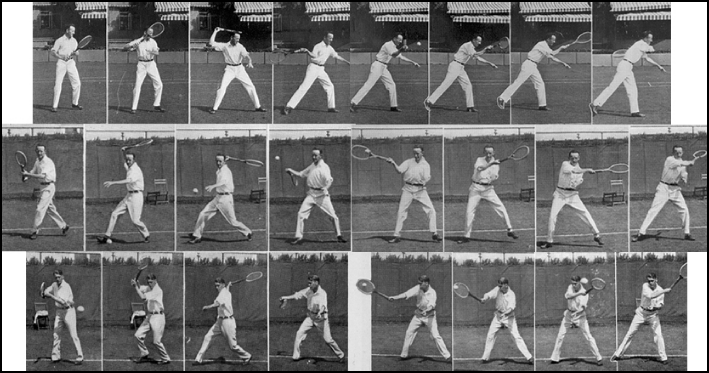Revolutionary Tennis |
||
Tennis Instruction That Makes Sense |
||
©2008, Mark Papas
MODERN TENNIS NOT Part 1: Move Forward, Step-Hit With The Semi-Open and Open Stance Part 2: The False Observation Of "Turn-Step-Hit" Part 3: Thinned and Confused: Tennis Science, Video Analysis. Part 1 Move Forward and Step-And-Hit With The Semi-Open and Open Stance The open stance era is now deeply embedded in professional tennis and in the tennis teaching world. Proponents of the "modern" game want you to coil the body first to "load" muscle body-power via the "kinetic chain," and then uncoil or unload it by rotating the hips and shoulders for power. Selling terms are "load, explode, and land," "modern tennis," "more racket acceleration for power," "play like the pros." It's no longer move forward into the ball, step-and-hit, right? How many of you, when trying the "modern" forehand, feel you're working too hard for the shot you're getting? Or wonder why you're not hitting a heavier ball or why something's off but you don't know what it is? Or, ironically, you feel a lack of power? All this means a basic fundamental is missing somewhere. THE SINGULAR FUNDAMENTAL: NOT IN THE OPEN STANCE? You are told to "work on your fundamentals" in any sport when your timing and rhythm are off, symptoms of which are your game's flat, things are off, it doesn't feel right. To get your feel back you return to something basic, something very simple you learned from day 1: a singular fundamental for timing and rhythm. Most often in sports the fundamental for timing is step-and-execute off the proper foot - step and throw, step and shoot, step and punch, step and kick, step and jump. What is a "fundamental" in tennis? Move? Unit turn? Sideways? Load? Racket back? Follow through? Rotate? None of the above. For tennis our singular fundamental is step-and-hit. A perfect analogy is with baseball. How do they teach little leaguers to throw? To turn, step forward with the front foot, and throw. Tennis is no different. We turn at least the torso or angle the body, step forward with the front foot, and swing. Our timing comes from the front foot taking a step, not by turning, and the rhythm for the stroke comes from shifting body weight. This begs the question, where is the fundamental of step-and-hit in the open stance load/unload scenario? If it's there why isn't it taught, but if it's not there does the open stance offer a new "fundamental" for our game? It is not a coincidence we value, and see the grace in, the playing style of Federer and Sampras over Rafael Nadal and his fellow dirtballers, and it is not a coincidence this playing style rises to the very top (not to discredit the dramatically open stance players). Common sense says a "fundamental" is the taproot upon which other layers can be added organically, regardless of era. If this holds true the open stance must use the step-and-hit, mustn't it? The tennis teaching world understands the step-and-hit as stepping forward with the front foot, or even across at times perhaps, to shift your body weight/momentum onto the front foot before swinging, and that you don't step literally the exact moment the racket hits the ball. But what the teaching world has never offered is that the step-and-hit is primarily a timing step and not a step for power: The front foot touches down and the stroke, or the throw as in baseball, occurs. Garret, a Revolutionary Tennis reader in Norway (!), sent me some Federer forehands on YouTube to look at asking about the "modern forehand" as it relates to the Forward Stance. One of his clips showed Federer using the singular fundamental of step-and-hit in a semi-open stance, and I found another clip of him showing it from an open stance. Hence this white paper is because of Garret's smart email, I saw something that jumped out and needed mention. Today's open stance will use the step-and-hit for timing with the front foot if it's indeed a fundamental, but does it? Judge for yourself. With Federer's semi-open stance forehand return his back foot is down on the ground first, "loading," and his front foot is in the air. Then the front foot steps down onto the court - timing step - and the stroke is launched. This is step-and-hit, from a semi-open stance, and he moves forward with it. Federer is not alone in showing us how the singular fundamental has adapted to work with the open stance, he's just the best with it.
At first tennis' front-foot "step" put the front foot across and sideways (closed stance), then more forward and in-line directly ahead of the still-sideways back foot (neutral/square stance). Today both feet are identically angled, either alongside each other with the front foot slightly ahead or even with the back foot (open/semi-open forward stance), or they are in-line with the front foot forward (forward stance). Regardless of stance, step-and-hit is very much present. Federer uses the front foot as a timing step in most of his forehands, he often steps prior to the stroke even when he has spun the back foot around. He can adjust and prance the front leg up in the air or transpose the feet like others, but you can consistently find this timing step in his game. As a larger, more radical theory found throughout Revolutionary Tennis' pages, this step-and-hit with the front foot takes advantage of linear momentum, the cornerstone to body-power for a tennis player. As shown by Federer not a lot of it is necessary to empower the stroke, it does not have to be a long step in the old school sense, but it is clear his body as a whole is moving forward into the shot. Angular momentum, from rotation, will always be present, but it is not the wellspring for our empowerment and itself requires linear momentum to be used more effectively. Rotation alone will not make Federer's body move forward (seen with Nadal/Kuerten later). A second Federer forehand shows the same phenomena but this time from a full open stance. Loading, as it were, on the back foot and with the front foot off the ground, Federer then steps down with the front foot and delivers the stroke while also moving forward before/into the hit as the signage behind him shows. He is showing us the fundamental timing step of the front foot (then hit) at work in the open stance while also moving forward into the shot.
Move to the ball, then load, step, push, land, in semi or open stance. Not the Papas method or "new," forward and step-hit is the mother's milk of tennis.
I wouldn't want Nadal's forehand, or Kuerten's, but I'll take Federer's. I'll even take Tsonga's open stance, the way he did it while moving forward into the ball when he demolished Nadal in the 2008 Australian Open. Nadal's forehand has a lot of spin, he hits heavy, he's a great player, but he doesn't move forward into the ball nor time it off his front foot. Instead he spins his body in-place to propel his racket and his front foot goes backwards (graphic below his picture).
Learning via the step-and-hit does something to one's proprioception, it speaks to athleticism, timing, rhythm. It allows a student's game to grow and mature because adjustments and variations easily spring from our bread-and-butter. Federer's forward push off the back foot is how it's been done in the past, it shifts weight forward into the stroke/contact spot. Linear momentum is delivered from the back foot pushing, not the front foot stepping or reaching out to pull it, which is how Federer honors the age-old wisdom of moving forward without taking the long step. The penultimate step is always responsible for so many things: for proximity, for weight loading-cum-transfer/momentum, for stability and strength to support the stroking effort. Federer incorporates this as Budge, Kramer, Gonzalez, Segura, Laver, and Borg did before him, to name but a few, though now we're seeing an adaptation within a new environment, namely a faster game. Question becomes, is this a "modern" or "new" way of hitting the ball, or an update?
Let me give you some quotes from the USPTA's Player Development insert they send their member pros [Vol. 1, #6, 2005, alternate, Vol. 2, #4, 2005]: "Loading step: the loading step is the final step in the adjustment of the strike-zone setup, and should happen on every shot." As seen with the Federer examples the "load" step is not the final step but the penultimate one unless braking on the outside leg to hit. The front foot is "the final step in the adjustment" even when held passively out of the way or kept limp up in the air (active adjustment measures). "Teaching it [turn-step-hit] as the primary way for players to use their feet during the hitting phase of a forehand is doing an injustice to students." Perhaps trying to reinvent the wheel is doing an injustice to students. But the USTA says the opposite, from their High-Performance Coaching newsletter Vol. 6, No. 4 / 2004: "Therefore, as we teach our players the modern forehand, let's not overlook the basics of the square stance [turn-step-hit]. In fact, it may be prudent to still teach this stroke first, especially with younger children."
Stan Smith and his peers used the long last step, photo left, graphic center, because that is how they thought to transfer weight/momentum. The graphic far right marks the top of Smith's front foot and compares it to the top of Federer's front foot using his graphic above labeled "2 step." The back foot mark is the top of the back foot, common to both. There is a great difference in overall step length of the front foot between them. Why did Federer shorten this step, due to lack of time, power against him, grip changes? Maybe for all these reasons. Why retain the small step forward, because it's our singular fundamental? Is a small amount of linear momentum material, or has body rotation become the momentum-generating force of choice and Federer's short front step and forward body movement form a prerequisite for this rotation? Teaching organizations counsel linear momentum is still there in our shotmaking but that angular momentum is the "new" tennis since it takes advantage of the "kinetic chain [that] is the sequential coordination of body segments (feet, legs, hips, trunk, shoulders, arm and wrist) to achieve more force than would be possible if the player omitted any of the segments." I guess they're saying older players never coordinated their body segments. The confusion lies in attaching the term "linear strokes" with linear momentum, and "angular strokes" with angular momentum. Either way strokes are always angular in nature, not linear like "8 ball, corner pocket." Since the means of delivering linear momentum has been misunderstood it is no wonder its use in today's tennis is overlooked. In fact the long step causes the momentum to dissipate over time and today's version, used by Federer and others, causes a momentum crest like the shoreline causes an ocean wave to rise or break. These musings and more are the provenance of Part 2. Let's return to why the singular fundamental has been missed in the open stance and how this knowledge can help your game by uncluttering your path to improvement.
Same for teaching a little one how to play tennis, as shown on the far right. The kid's choking up on an adult racket, using the singular fundamental of step-and-hit, or front foot-contact, and his head's turned off to the side like... That's Federer, by the way, age 3, from the book "The Roger Federer Story," by René Stauffer. Good read.
The step-and-hit is seen in today's open stance forehand though its teaching is absent, and you wonder why. Baseball helps to explain.
In baseball you learn to throw stepping forward with the front foot. Over and over again until it's automatic, and then adjustments, adaptations, and variations to suit changing circumstances can occur. When Phil Rizzuto or Ozzie Smith threw off their back foot, or stepped their back foot around and into the throw, or threw sidearm, baseball analysts didn't swoon about a "modern" way to throw a baseball (Venezuelan hot corner man Marco Scutaro, above left, in what is not a modern way to throw a baseball). But for tennis adjustments and variations are called "new," or "modern," or a "new secret method" and you're taught to emulate it directly. We must be smarter than this. If a pro's adjusting or compensating we need to call it just that.
Photographic similarities from tennis and baseball. Baseball coaches do not encourage throwing off the back foot since it leads to throwing inaccuracies and offers less strength (2some left upper left, 4some right upper left). Why, then, does tennis think it's "Modern" when the pros do it? From Dementieva (2some left upper right) to Srichaphan to Roddick to club players (4some right), hitting off the back foot with the front foot off the ground is less effective, just like when throwing a baseball off the back foot with the front foot off the ground. There is a better way.
If you are experiencing timing/rhythm problems try the step-and-hit from any stance. If you want to improve your power, try the step-and-hit. You don't have to keep the feet in-line as shown in the Forward Stance, but by stepping with the front foot prior to the swing you create a timing step that feeds your athleticism. Organically. Truth be told, it's not step and hit, it's step, shift-and-hit. You can step with the front foot yet hold your body weight on the back leg but it feels awkward when you finally shift it forward and swing. Nevertheless the last step is a timing step because it's giving the green light to the body to shift. You wonder why some swings feel really awkward after you're been waiting for the floater? Because you haven't taken a step just prior to your swing, you've been standing around and your last step was seconds ago.
Part 2: Modern Tennis Not The False Observation Of "Turn-Step-Hit" Throwing The Baby Out With The Bathwater The elephant on the court is "Turn-Step-Hit" because it is always presented as the baseline model to compare against what's new and what's different. It is labeled "traditional/classical/foundational" against the current technique called "modern tennis/current game." But the understanding itself of "turn-step-hit" is flawed, it is a technique used for beginners and is not a baseline model. Therefore opinions formed using "Turn-Step-Hit" in comparison arguments will be hollow. Expose this old canard and a unifying form appears regardless of era. First the definition of "Turn-Step-Hit" from Tennis Magazine's "The Tennis Magazine Primer, A complete guide to the basics of the game": TURN From the ready position, coil your trunk from hips to shoulders as you take the racquet back. Pivot your feet and shift your weight back.[the entire quotation] STEP .... Step forward [to] target. Let your forward weight-shift trigger your forward swing... HIT ...As you uncoil your trunk and swing forward.... Second, the definition of "load-explode-land" from the USPTA's Player Development Program, Vol 1., No. 6 / 2005:
A quick look shows no difference. "Coil your trunk" is "Loading is facilitated by rotation of shoulder and hips." "Uncoil your trunk and swing forward" is "Exploding" through the shot. But first let's look at "Turn-Step-Hit."
As a junior I noticed players in real-time did not turn-pivot from the ready position because they first moved to the ball, and that before they stepped into the ball to hit their back foot was angled in the "pivot" position. The next-to-last step was "pivot," the last one "step." I figured tennis teaching just did a cut-and-paste job with these last two steps - pivot/step - to teach beginners because it was obvious "turn, pivot, step and hit" wasn't the mantra for real-time technique. The mantra for real-time technique was "step and hit." You'd run towards the ball, you were turned, your back foot pivoted and carried your body weight, and then it was all about step and hit. "Step-hit" is the baseline model to tennis how-to form, in no small part because it is the singular fundamental. "Turn-step-hit" is for beginners. When "new/modern" tennis ideas are held superior or better to "turn-step-hit" it's like a bicycle company noting their modern two wheelers are superior to bicycles with training wheels.
The "load" is seen in both, top left "turn-step-hit," top right "modern" with Roddick. In both the torso is coiled, the weight is on the back leg, the front foot is on toe, the front arm is turned to the side. Energy is stored just as dramatically in "turn-step-hit." The middle photos show step-hit, the heel of the front foot has touched down, though the model steps forward and Roddick does not. "Explode" occurs when the back foot pushes momentum into the ball, witnessed when the back foot's heel is off the ground, bottom two photos. If the "step" is forward then momentum goes forward into the shot, even with a step in-place. When you push and the body goes off to the side, or spins on its axis and front goes to back and back goes to front, then momentum is not going forward. We want momentum to go forward into the shot, don't we?
The statement: "Linear momentum is created by the forward step in a square stance forehand" is false on many fronts (USTA High Performance Coaching Newsletter for Coaches, 2004).
Therefore, linear momentum is created by any length of forward step with the front foot from any kind of stance (and presumably if stepping forward only with the back foot). In fact Roddick's return showcases bad form, he's been pushing off to his left away from the ball and ends farther behind the baseline for it. His example shows us what we should not be doing though it's showcased for pros' learning by the USPTA and its Education Committee and Player Development Advisory Council. Federer's ad court return clearly shows he has gone forward instead of spinning around on an axis to face an opposite direction. Roddick's example is not of a ball in too close on him, he has taken a large outside step to load because he thinks that is best, and though his front foot is ahead of the back he chooses not to move forward with it because he's been trained to do this massive rotation thing. On the other hand Federer's return is close in on him but he will choose to move forward into the ball. Whose example would you follow?
HOW THIS SHORTER STEP WORKS IN THE STEP-HIT a hypothesis Ever caught your toe walking on the sidewalk? You know what happens, you're propelled forward, sometimes up and then forward. Your forward movement, or momentum, gets interrupted by what happens at ground level, and, from a layperson's point of view, you become top heavy. Now try this in a controlled manner. Take some normal walking steps and then do a half step while assuming you'd take another step. There is a continuation of momentum.
A tsunami is a series of waves moving along the ocean floor with a lot of energy and a long wavelength to it. It doesn't become the killer wave rising many feet above the ocean surface until its long wavelength is slowed down, interrupted, and compressed by land. When tennis players "load" on the penultimate foot this is one crest of a wave, the second step with the front foot is the second crest that defines the wavelength. When Stan Smith takes a long step forward to the ball that looks like long wavelength; Federer's shorter forward step is a shorter wavelength. Smith's long wavelength has "X" amplitude; Federer's shorter wavelength has an increased amplitude greater than "X" since he's propelled upward/forward. Roddick's lack of a second step and forward movement leaves him with no other choice than to rotate in-place to generate momentum. He basically muscles the ball over, creating a lot of work. Federer's short step with the front foot for all the right reasons becomes today's version of (yesterday's) "step into the ball and use forward momentum." The short step, as the second crest to define a short wavelength, interrupts the gait and causes a spike in momentum. But he keeps his balance during this forward-momentum-moment because he's planned for it and pushes hard from the back foot to increase the amplitude as a whole to this wavelength. This is where and how the energy goes forward using a semi-open or open stance in today's faster game.
Why the shorter step? Stepping forward into the ball using a Forward or Square Stance with the semi and/or western grips is too uncomfortable to be productive or effective. If it weren't pros would do it and they don't, they open their bodies to get the proper body support (avoid injuries) and hit on time. This is how it works.
In #3 I keep the stance, forward step, semi western grip, and contact point as in #1. But I feel like I am hitting too far out in front for my position, and my back hip and hitting shoulder feel uncomfortable, as would yours. In this position my biceps feels pinched against the side of my chest, #5 where the horizontal stripe on my shirt meets my shirt sleeve. I change only my stance, #4, to hit out in front without feeling too far out in front. This position, #6, eliminates the pinched feeling in both back hip and hitting shoulder. I suspect this is injury prevention as well. I like the shadow line between my feet, it acts as a marker denoting how the semi-open stance brings both the back leg and hip around and forward, and it marks my racket hand placement. Where I stood at 6 o'clock (back foot) and 12 (front foot) the semi-open stance is at 3 o'clock and 10. And if you draw a vertical axis through the middle of my body down through my groin to the court below it seems I am merely rotating on this axis when adjusting my feet. This is the axis the body turns on best when rotating, not one through the outside back leg and hip as the USPTA manufactures in their analysis of Kuerten's open stance forehand. It is fun to speculate that if Stan Smith had taken a shorter last step into the ball he would have hit the ball harder for it. [Also he would have rotated a bit more as well, though still moving forward into the ball first, a prerequisite, and not the other way around.] Taking a shorter step at the end doesn't guarantee more power, it merely explains how the step-hit works in the open stances. It works like this because of the energy pros bring to the moment prior to that interrupting short step, they are all electric in their positions prior to hitting the ball, bundles of energy waiting to be released.
CONTACT VALUE It's not merely a question of being turned, coiled, "loaded," these are static terms. Prior to step-hit pros are like the tsunami wave moving fast along the bottom of the ocean with the energy of a widebody jetliner in flight. They are focusing on the contact value, or at least should have been trained to, instead of reacting with loading, rotational gobbledegook. Tennis is all about hitting the ball, yes, but more about the value of that contact. Contact value is all about how clean the contact was, how favorable to the player the work-results ratio was. Focusing on the wind-up prior to the hit in one's attempt to have an explosive contact merely degrades its value. Next time your pro asks you to focus on all the "modern" tennis stuff tell him, "I don't need to show you no stinkin' follow through! I'm gonna show you great contact!" The USPTA offers the "modern" technique is an "angular hitting style" that uses a "kinetic chain" to produce "angular" strokes instead of "linear" strokes (and thus more powerful shots). For them a "linear stroke" is a straight line hitting path, I guess following through and holding it out to the net, and "angular" is the wrap around-ish follow through. As seen from 1926 photos the wrap around-ish "angular" hitting style was very much present because all strokes are angular, some more or much more than others, even when hitting flat and straight. Also seen: western grips (top two panels, same player), "loading" (all three), semi and open stances (bottom two), lo-ong step-hit (top), prancing front leg up like Kuerten (middle), outside leg braking to hit (bottom).
We are indeed throwing the baby out with the bathwater here. Time to stop. The implication is linear momentum is not as materially important to creating our power as angular momentum via body rotation, and that some things "new" need to be added. We are seeing long established form and structural methods in a predominantly open stance environment and faster game. Calling it new with all the new stuff and distinctions we're supposed to do and be aware of, along with the reams of analyses and breakdowns, makes playing tennis that much more difficult to do, turns people off even. Witness: "The angular hitting style includes several footwork patterns that work in different situations [italics mine]." "Six General Performance Components... Footwork is only one of the 43 subcomponents." ˇAy! Want to hit better? Open up the stance a bit, still push off the back foot, still use your step-and-hit but a shorter step. Remember the ball's angling away from you so don't shift away from it. There is a need to open your stance from time to time, but that's not "modern" by any means. You already do that on your own, you may be unaware of it. You also stretch your muscle groups more from time to time for more oomph, but you already turn and "load" like that from time to time and may also be unaware of it. Your tennis teacher should be pointing out to you how you hit these marks naturally from time to time as s/he leads you down your road of self-awareness. You already do this, it's been there all along. Don't complicate matters. Tennis is not rocket science, And now it's time to clear up our confusion. On to Part 3, Thinned and Confused: Tennis Science, Video Analysis, Part 4., Hiding In Plain Sight.
|
|||||||||||||
|
|
||||||||||||||||||||||||||||||||||||||||||||||||||||||||||||||
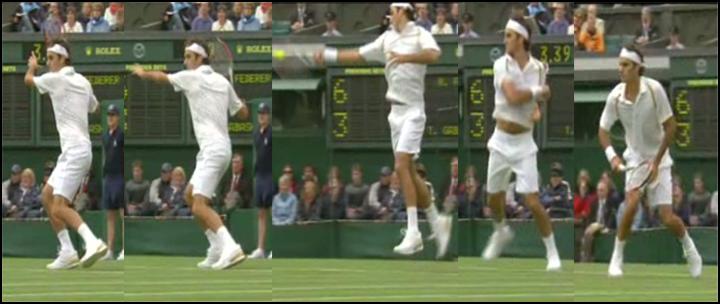
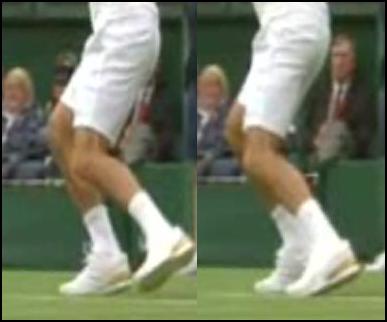

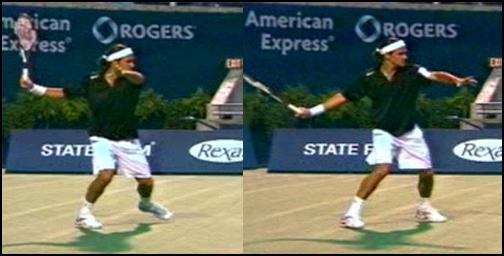


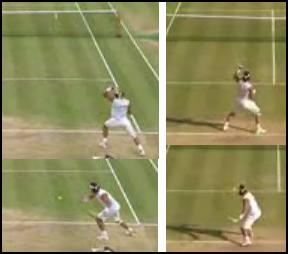
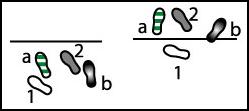
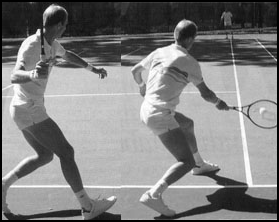
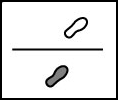
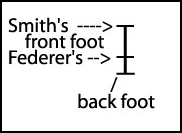
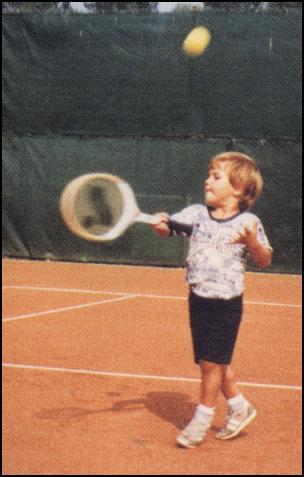
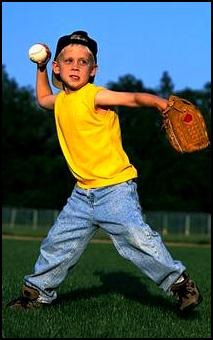
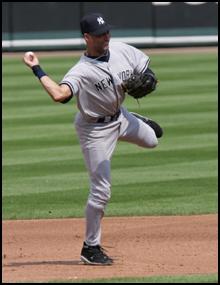
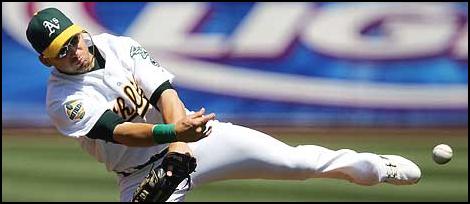
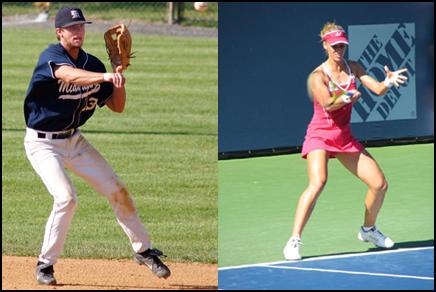
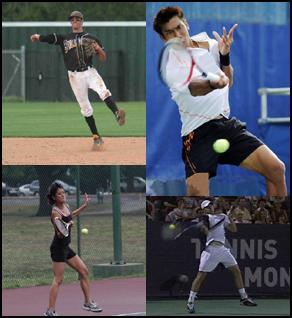

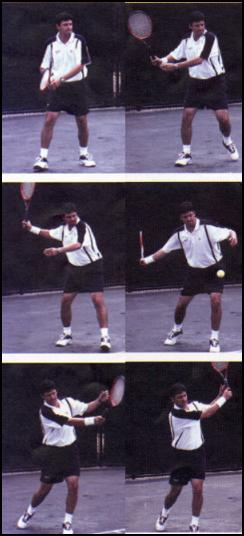 As a beginner I was taught from the ready position to "turn, pivot, step and hit." I'd "turn" my upper body, "pivot" the (outside) back foot in-place, keep my weight there and turn my back hip, then "step" forward with an angled front foot and "hit." On the right is the 6 photo example of turn-step-hit the USPTA uses as a comparison basis with load-explode-land. (Ironically the upper right photo of the "old" technique is part of the "modern" nomenclature, "unit turn".)
As a beginner I was taught from the ready position to "turn, pivot, step and hit." I'd "turn" my upper body, "pivot" the (outside) back foot in-place, keep my weight there and turn my back hip, then "step" forward with an angled front foot and "hit." On the right is the 6 photo example of turn-step-hit the USPTA uses as a comparison basis with load-explode-land. (Ironically the upper right photo of the "old" technique is part of the "modern" nomenclature, "unit turn".)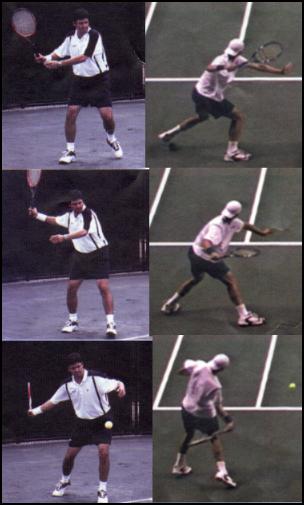 Photos on the right are from the same USPTA's Player Development Program used to show the differences of old and new, but they are similar. The "new" (right column) is shown by a pro in action while the "old" (left column) is shown with a model standing still, as is always the case.
Photos on the right are from the same USPTA's Player Development Program used to show the differences of old and new, but they are similar. The "new" (right column) is shown by a pro in action while the "old" (left column) is shown with a model standing still, as is always the case.
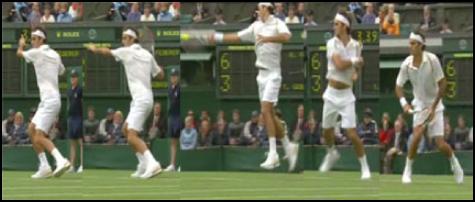
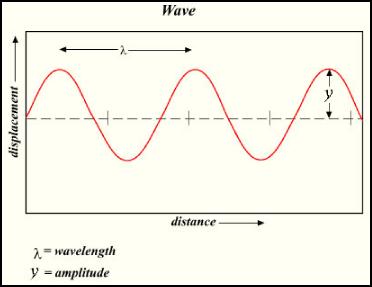 Walking can be patterned as a series of waves where two steps represent two crests of a wavelength, with a trough and amplitude. If you walk faster the wave on the right becomes more compressed, that is the distance between the crests is less since they happen more frequently. Running increases the crest height, or amplitude.
Walking can be patterned as a series of waves where two steps represent two crests of a wavelength, with a trough and amplitude. If you walk faster the wave on the right becomes more compressed, that is the distance between the crests is less since they happen more frequently. Running increases the crest height, or amplitude. Photos on the right illustrate the difference a semi western grip places on the racket face, contact point, body, and feet versus an eastern. #1 is an eastern grip, stepping forward, a Forward Stance, and with the racket on the net post as the contact point out in front (more or less). This all feels good. I switch the grip to a semi western in #2, nothing else, and the racket head lays back all on its own. Making contact like this I am late, I have to push the racket face forward, #3.
Photos on the right illustrate the difference a semi western grip places on the racket face, contact point, body, and feet versus an eastern. #1 is an eastern grip, stepping forward, a Forward Stance, and with the racket on the net post as the contact point out in front (more or less). This all feels good. I switch the grip to a semi western in #2, nothing else, and the racket head lays back all on its own. Making contact like this I am late, I have to push the racket face forward, #3.